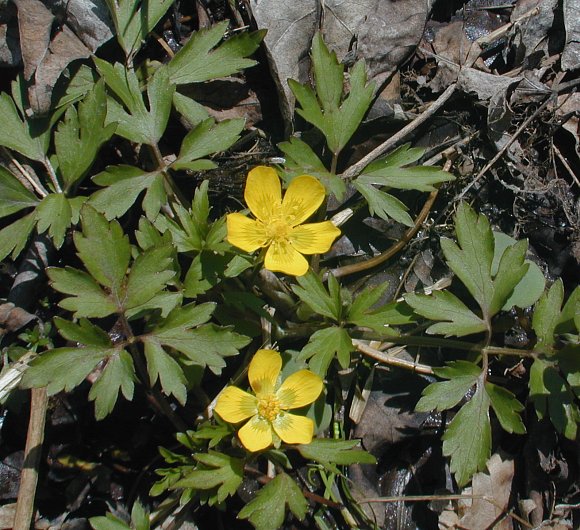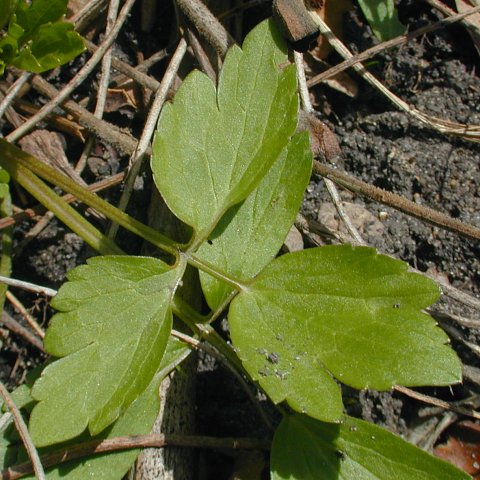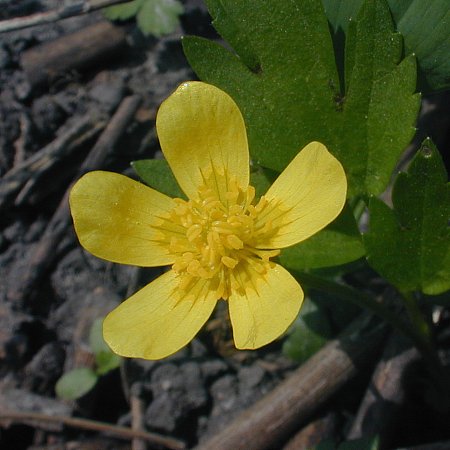Description: This herbaceous perennial plant is about 6" tall, although its stems can extend up to 1' long. Both basal leaves and stems with alternate leaves are produced; the latter usually sprawl across the ground. The stems are light green, reddish green, or brownish green, and glabrous to sparsely pubescent. The basal and alternate leaves are up to 3" long and across (excluding the petioles); they are yellowish green to dark green, trifoliate, and glabrous. The leaflets are obovate, broadly obovate, or rhombic in outline and their margins are shallowly to deeply cleft and coarsely dentate. The terminal leaflet has a longer petiolule (basal stalklet at its base) than either of the lateral leaflets. There is some variability in how broad and deeply cleft the leaflets are across different populations of plants. The petioles are up to 3" long, light green to reddish green, and glabrous to sparsely pubescent; they are grooved above and convex below.

Occasionally, individual flowers develop from unbranched stalks about 2-5" long. These stalks are ascending to erect, green, and glabrous to pubescent. Each flower spans about ¾" across, consisting of 5 yellow petals, 5 light green sepals, numerous yellow stamens, and a cluster of pistils in the center of the flower. The petal bases are often pale yellow with fine veins functioning as nectar guides; the remainder of the petals are bright yellow and shiny. The petals are obovate with rounded tips; they are longer than the sepals. The blooming period occurs from mid-spring to early summer and lasts about 1½ months. After the petals fall away, the pistils are replaced by a cluster of flattened achenes with long beaks; these achenes are 2.5-3.5 mm. in length. The root system consists of a tuft of fibrous roots. The sprawling stems are able to form rootlets when their nodes establish contact with moist ground. Swamp Buttercup sometimes forms loose colonies of plants at favorable sites.

Cultivation:
The preference is partial sun to light shade, wet to mesic
conditions, and a fertile loamy soil with some decaying leaf mould.
Standing
water from spring rainfall is tolerated if it is temporary.
Range & Habitat:
Swamp Buttercup is a common plant that occurs in most counties of
Illinois (see Distribution
Map), where it is native. Habitats include
moist to mesic deciduous woodlands, soggy
areas along vernal pools, swamps, partially shaded areas of seeps, and
areas along springs in woodlands. This species often grows in soggy
areas of
woodlands that are too wet for some invasive species, such as Alliaria
petiolata (Garlic Mustard). Therefore, populations of Swamp
Buttercup remain reasonably secure. This plant is also able to tolerate
some degradation of its habitat from other causes.

Faunal Associations: The flowers attract their fair share of flower visitors, including little carpenter bees (Ceratina spp.), mason bees (Osmia spp.), Halictid bees (Halictus spp., Lasioglossum spp.), Andrenid bees (Andrena spp.), Syrphid flies, bee flies (Bombylius spp.), Muscid flies, Anthomyiid flies, skippers, and miscellaneous beetles. The bees suck nectar or collect pollen, while the flies and beetles suck nectar or feed on pollen. Other insects feed destructively on the foliage, roots, and other parts of Swamp Buttercup and other buttercups (Ranunculus spp.). These species include the leaf beetles Prasocuris ovalis and Prasocuris vittata, larvae of the sawflies Monophadnus pallescens and Stethomostus fuliginosus, Thecabius affinis (Poplar-Buttercup Aphid) and Thecabius gravicornis (Folded-Leaf Balsam Aphid), and larvae of the moth Sparganothis sulfureana (Sparganothis Leafroller). The foliage of buttercups is more or less toxic and it is avoided by mammalian herbivores. However, the seeds of these plants are eaten to a limited extent by the Wild Turkey, Cottontail Rabbit, Fox Squirrel, Gray Squirrel, Eastern Chipmunk, and Meadow Vole. The Wild Turkey reportedly browses on the foliage of buttercups, notwithstanding its toxicity (Martin et al., 1951/1961).

Photographic
Location:
A moist deciduous woodland at Busey Woods in Urbana, Illinois.
Comments:
With the exception of the weedy Ranunculus abortivus
(Small-Flowered Buttercup), this is probably the most common buttercup (Ranunculus
spp.) in Illinois. It is possible to confuse Swamp Buttercup
with similar species, especially Ranunculus hispidus
(Hispid Buttercup), Ranunculus carolinianus
(Carolina Buttercup), and the introduced Ranunculus repens
(Creeping Buttercup). Unlike Swamp Buttercup, the stems of Hispid
Buttercup have abundant spreading hairs and they are usually more
erect. Carolina
Buttercup is supposed to have longer achenes (3.5–5.0 mm. in length)
than the preceding two species, however its status as a separate
species is debatable. Some authorities consider Swamp Buttercup and
Carolina Buttercup to be different varieties of Ranunculus
hispidus (Duncan & Duncan, 1999; Yatskievych, 2000),
although Mohlenbrock (2002) doesn't. The leaves of Creeping
Buttercup are less
deeply cleft and they are often splotched with pale green or white
patterns. In addition, its achenes are less
flattened than those of Swamp Buttercup.